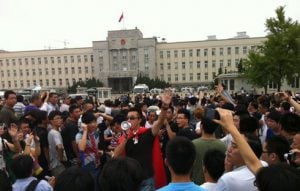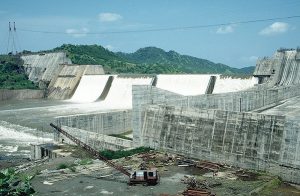Thousands of demonstrators took to the streets in northeastern Guangdong on Sunday to protest against a new coal-fired power plant, just weeks after a documentary on smog was viewed by hundreds of millions of people in China as concerns grow over China’s toxic air.
According to a report in the South China Morning Post, up to 10,000 demonstrators gathered in the centre of Heyuan, chanting “Give me back my blue sky” and “Go away power plant”.
Some of the protesters held small signs that read: “Stop feeding people with smog” and reports said minor scuffles were reported between protestors and police.
The protest comes as China’s central government aims to clean up the country’s toxic air by tightening environmental regulations and enforcing rules more vigorously, but in the year since premier Li Keqiang called for a “war on pollution”, there has been scant improvement in air quality in many parts of China.
Heyuan is close to the Xinfengjiang Reservoir, a major source of water for Guangdong and for Nongfu Spring, a popular brand of bottled water.
The city already has one coal-fired power station and a new plant, to be built by Shenzhen Energy, would cost an estimated 8 billion yuan and generate 11 billion kWh annually.
State-owned news agency Xinhua reported on the demonstration and estimated that the number of participants as around 1,000, but photos of the gathering suggested the crowd could be much bigger, the SCMP said.
The protests come a week after a demonstration in another Guangdong city, Luoding, turned violent, persuading the local authorities to cancel plans for a controversial incinerator.
Commentators on China’s environmental policy said there were elements to the Heyuan demonstration to link it to the ‘Under the Dome’ documentary.
However, the protests appear to have been planned for a while and were not the sudden, spontaneous outbursts of public anger that are often judged to be much more of a threat to government control.
“What’s interesting is that the demonstrators were calling for blue skies, suggesting that quality of life issues are high up the list of concerns for residents of smaller Chinese cities too,” said Tom Johnson, an academic with Hong Kong’s City University.
Last week, a report commissioned by the Chinese government warned that smog in China could contribute to serious social unrest unless air quality is improved.
Figures released in January showed that the Pearl River Delta cluster of Guangdong’s southern big cities and Hong Kong had experienced a slight drop in PM2.5 pollution in 2014, but that ozone levels had risen.
In 2009 Guangdong’s government said it would ban the construction of new coal and oil-fired power stations in the Pearl River Delta region, but green groups say the curbs haven’t been strictly enforced.
Meanwhile, the addition of new capacity in other areas of China’s most populous province appears to have shouldered cities such as Heyuan with the environmental burden of hosting polluting power stations.






